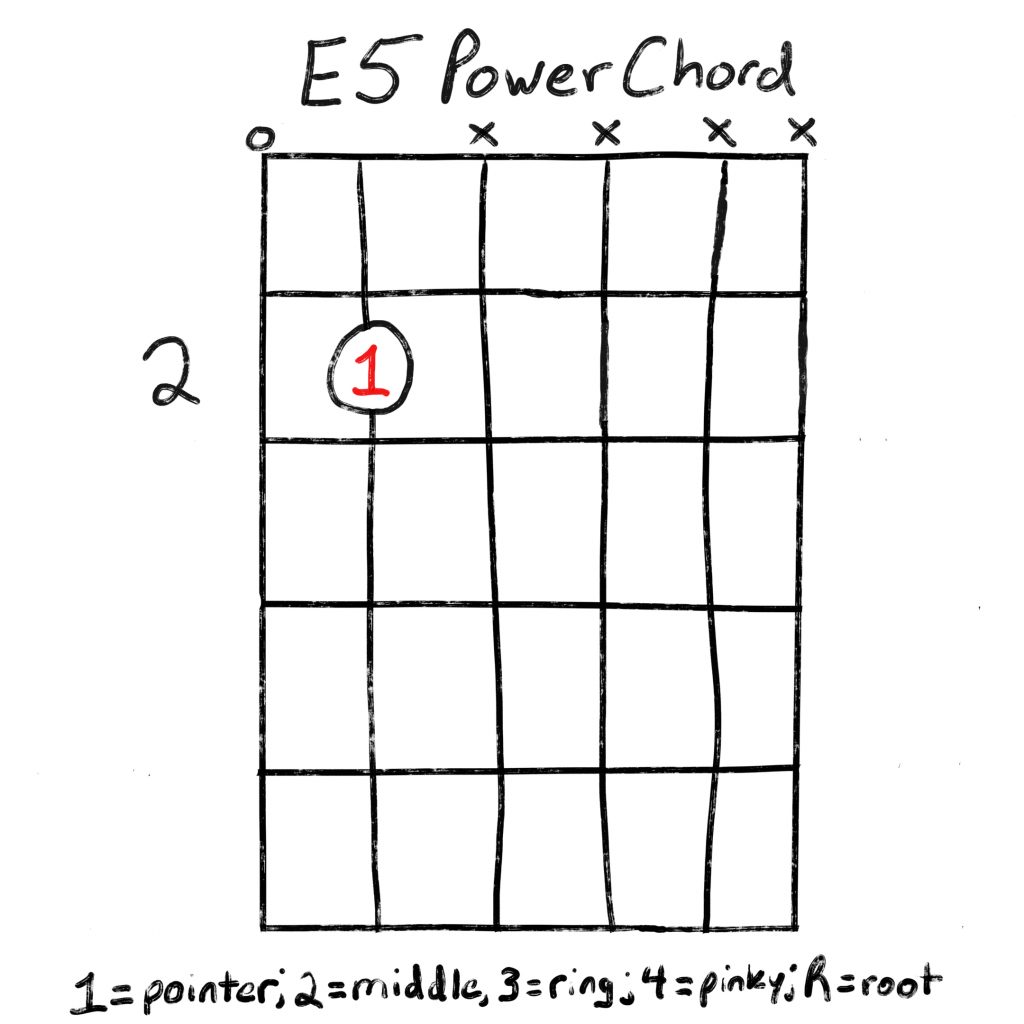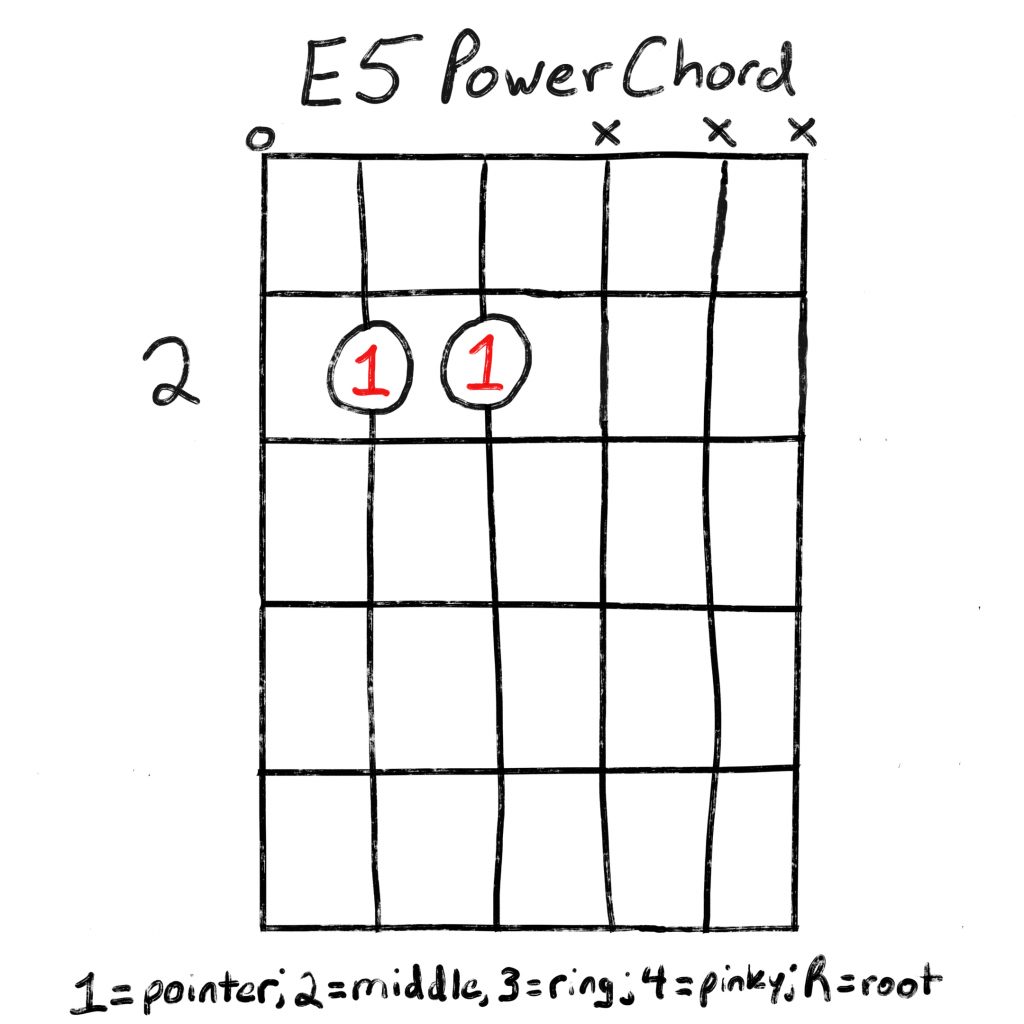You can't properly play rock & roll or punk rock without a good handful of power chords. And the easiest power chord of them all is the E5 chord.
The truth is, power chords are found in many more genres than just rock and punk. The simplicity of just 2 or 3 notes played at once is often just what a phrase needs.
Unlike some more complicated chord, like a B7, power chords are able to be played only using 2, 3, sometimes even 1 finger. The E5 guitar chord is one of those single finger chords.
So, plug into your amp, crank the volume, throw in some distortion, and let's learn how to rock out with an E5 chord!
How To Play The E5 Chord

You can't find an easier chord to play. You only need 2 strings and 1 finger.
- index finger (1) on the B note of the A string on the 2nd fret
- play the low E string open
- mute all of the other strings
Variations Of The Chord
Power chords generally have 2 or 3 notes. This variation adds in an additional E note for a little extra oomph!

- index finger (1) on the B & E notes of the A & D strings on the 2nd fret
- play the low E string open
- mute all of the other strings
You can also play an E5 further up the neck.

- mute the low E string
- index finger (1) fretting the E note on the A string at the 7th fret
- ring finger (3) fretting the B note on the D string at the 9th fret
- mute the remaining strings
Similar to the 3 note version on the 2nd fret, this variation also adds in an additional E note.

- mute the low E string
- index finger (1) fretting the E note on the A string at the 7th fret
- ring finger (3) fretting the B note on the D string at the 9th fret
- pinky finger (4) fretting the E note on the G string at the 9th fret
- mute the remaining strings
Moving further down the neck up to the 12th fret...

- index finger (1) on the E note of the D string on the 12th fret
- ring finger (3) on the B note on the A string on the 14th fret
- pinky finger (4) on the E note on the A string at the 14th fret
- mute the rest of the strings
The Theory Behind It
In music theory terms, a 5, or V, chord is a chord using only the 1st and 5th, or I and V. These chords are major because they lack a 3rd, or III, to make them minor. To make the chord you only need the I and V notes.
- E (I)
- B (V)

The E major scale looks like this:

Complementary Chords
To build a chord progression around the E5 chord, you can use the E major chord scale. Since 5 chords are also known as power chords, we decided to go with a progression that is synonymous with pop, rock, punk, you name it; the I - V - VI - IV progression.

This is how you play that progression:




A Couple E5 Chord Variations
We have a few more variations for you to try out.

- index finger (1) barred across the B & E notes on the E & A strings on the 7th fret
- ring finger (3) fretting the B note on the D string at the 9th fret
- mute the other strings
One final variation is a bit trickier than the others. With this version you must mute the top 2 and bottom 2 strings.

- index finger (1) on the E note on the D string on the 2nd fret
- ring finger (3) on the B note on G string on the 4th fret
- mute the low E, A, B, and high e strings
Songs That Have The E5 Chord
Here are some popular songs across multiple genres that have an E5 chord in them:
- Hit Me With You Best Shot by Pat Benatar
- Iron Man by Black Sabbath
- Godzilla by Blue Oyster Cult
- Basket Case by Green Day
- Stand By Me by Ben E. King
- I’m Not Okay (I Promise) by My Chemical Romance
- Lithium by Nirvana
- Pretty Fly For A White Guy by The Offspring
- Feel It Still by Portugal, The Man
- Go With The Flow by Queens Of The Stone Age
- Blitzkrieg Bop by The Ramones
- Give It All by Rise Against
- Rock You Like A Hurricane by The Scorpions
- Wild Thing by The Troggs
- Vertigo by U2
- Beverly Hills by Weezer
Final Word
As you can see, the E5 is a very easy and versatile chord. You can play it all up and down the neck. Not only is it a great way for a beginner to break into song writing but it will stand the test of time as you gain experience.
See what you come up with the next time you play!

Paolo says
Thank you for this crystal-clear explanation. In my case, it was of great help while trying to get the E5 chord right in AC-DC's Back in Black, especially in the fast A5-E5 and E5-B5 passages found in the chorus.
Keep up the great work!
Paolo